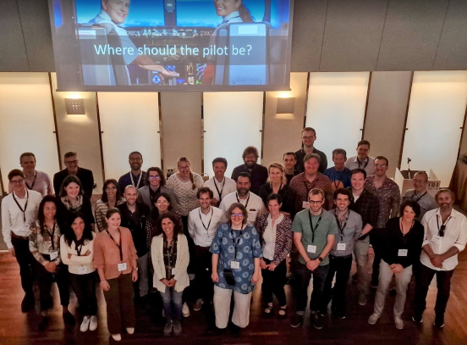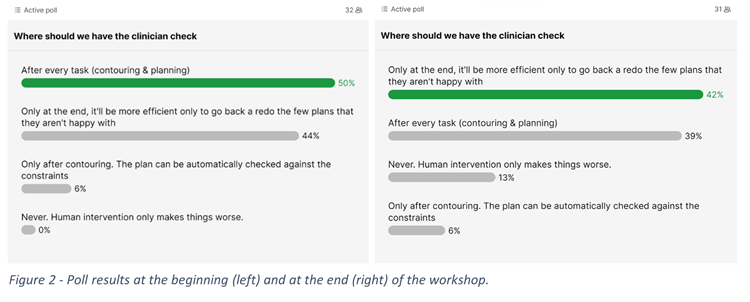2023 ESTRO Physics workshop: Science in development
AI for the fully automated radiotherapy treatment chain
13-14 October 2023, Turin, Italy
PDF version
Chairs: Stine Korreman, Tomas Janssen, Charlotte Brouwer
A group of 31 people from 12 different countries met in Turin last October to explore various ways of supervising autopilot flight systems; or so it seemed (Figure 1). The workshop "AI for the fully automated radiotherapy treatment chain" featured two days of invited lectures, presentations by participants, brainstorming discussions in large and small circles, a live auto-planning challenge, concrete action points, pasta and plenty of Italian coffee.
The first question we set out to answer in this workshop was whether or not institutes are currently able to perform fully automated end-to-end treatment planning, from scan to treatment plan. A web-based automation challenge had been set up by the organisers a few months prior to the workshop. Planning CTs and corresponding treatment prescriptions were provided to participants, who were then asked to submit the corresponding structure sets, dose distributions and plans, generated with the least amount of manual intervention possible. Some of the challenge participants presented their solutions on the first day of the workshop. These ranged from artificial intelligence (AI)- to classic optimiser-based, and from fully research-based to combining clinically used tools. The answer to the question above was a resounding "yes, we can"; and because “seeing is believing”, participants had the opportunity to demonstrate, during the live challenge, how their automated pipelines could be applied to unseen cases.
The second question that inevitably arose was: what is keeping us from deploying full automation in clinical practice if we can get from a CT scan to a deliverable treatment plan with virtually no human input? This question served as a springboard for the workshop’s second major subject, which was the quality assurance (QA) of AI in the clinic.
The analogy with autopilot flight systems came up early in the debate and set the tone for the next two days. Inclusion of a human "pilot" to oversee the fully automated treatment planning pipeline seemed like a sensible idea. Where should this pilot then be placed? At the very end (after the plan is made), somewhere in the middle (after auto-contouring, before planning) or not at all? At first participants in the workshop were hesitant to embrace the idea that the pilot should be placed only at the very end of the process, but their perspectives were shifting by the end of the second day, with some even coming to the conclusion that “human intervention only makes things worse” (see Figure 2). A possible explanation for this change was one of the outcomes of the risk analysis exercise on the QA of a fully automated workflow, which showed that the most severe mistake that could happen was when a person initiated the wrong automation protocol!
This workshop laid the groundwork for multiple brainstorming sessions and probably raised more questions than it answered. However, a number of action points were developed in the form of working groups, to summarise the discussions and present concrete proposals. These are listed below.
- Reach a consensus on the content of “model fact sheets”: what information should AI providers disclose to customers about model training?
- Conduct a consensus risk analysis to identify problematic steps and mitigation strategies.
- Review and communicate what we can learn from aviation and other fields that involve the use of automated and manually supervised processes.
- Develop databases of images, consensus contours and plans.
- Write an article on the automation challenge, which should include a description of the participating approaches.
- Organise future editions of the automation challenge (participants expressed strong interest in keeping it going).
- Provide training/education through webinars and tutorials.
- Arrange funding for networking.
These groups have been meeting since the end of the workshop and we all look forward to their upcoming contributions to the community!

Figure 1 - Participants and organizers.

 |
Rita Simões
Clinical scientist
Netherlands Cancer Institute
Amsterdam, the Netherlands
|